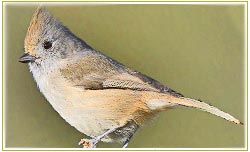About The Oak Titmouse
 The Oak Titmouse used to be part of the species called the Plain Titmouse, along with the Juniper Titmouse. The Oak Titmouse is gray in color with a small head tuft that helps in its identification out in the field. Its back is brownish-gray, while the undersides are a lighter shade of gray. It has dark eyes, a tiny dark beak, and a long tail. Male and female Oak Titmouse have the same physical characteristics. This breed is a breeding-season resident of parts of the Western side of North America. It is so-called due to its preference for dry, warm oak pine and oak forest areas.
The Oak Titmouse used to be part of the species called the Plain Titmouse, along with the Juniper Titmouse. The Oak Titmouse is gray in color with a small head tuft that helps in its identification out in the field. Its back is brownish-gray, while the undersides are a lighter shade of gray. It has dark eyes, a tiny dark beak, and a long tail. Male and female Oak Titmouse have the same physical characteristics. This breed is a breeding-season resident of parts of the Western side of North America. It is so-called due to its preference for dry, warm oak pine and oak forest areas.
The Oak Titmouse Nesting Preferences
The Oak Titmouse puts its nest together in a hole in a tree that is made of grass, feathers, hair and moss. The female has between 5 to 8 pure white or brown-spotted eggs at a time, which she will incubate for 14 to 16 days. This breed may also nestle in crevices of old buildings.
Building a Birdhouse For The Oak Titmouse
The birdhouse size recommended for this type of bird measures approximately 4 inches in length x 4 inches in width x 8 to 10 inches in height. The entrance should be placed about 6 to 8 inches from the floor of the birdhouse, and measure about 1¼ inch across. An elevation of 6 to 15 feet from the soil should suffice.
The Oak Titmouse Mating Habits
Oak Titmouse form bonds that last their whole life span, and upon pair formation, defend their territories all year. The first fall in an Oak Titmouse’s life brings a rite of passage; those that fail to find a mate then will be barred from any territory claiming. They are forced to live in inferior habitat until a vacancy allows them in prime territory. Both male and female in a mated pair defend their territories, where they may be found foraging for food, roosting, nesting, and others.
The Oak Titmouse Feeding Preferences
Seeds are primary nutrient sources for this species. The types of seeds include poison oak, thistle, weed, oat, oak and pine. Oak Titmouse strike seeds on branches to crack them open. Invertebrates from the ground are also possible choices. Bird feeders often attract the Oak Titmouse. They may also be found gleaning tree barks and foliage, and they also use their beaks to take arthropods out of hiding. Hovering and chasing are also possible ways of catching another type of prey—the flying insects. During instances when the insects captured are large, the Oak Titmouse will hold it by using its foot and pull it apart using the beak to make more manageable food portions.
Interesting Oak Titmouse Facts
One of the Oak Titmouse’s odd characteristics is that the breed does not merge into flocks during the winter. It also tends to switch trees or perches almost continuously. A habitat near trees tends to be most preferable, and as well as a pattern of directly flying to a perch from the ground. It is important for Oak Titmouse to have ample roosting cover in its habitat. It is classified under the order Passeriformes, family Paridae, scientifically named Baeolophus inornatus.